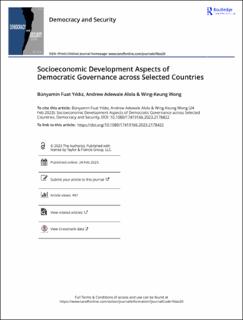Socioeconomic Development Aspects of Democratic Governance across Selected Countries
Peer reviewed, Journal article
Published version
Permanent lenke
https://hdl.handle.net/11250/3119387Utgivelsesdato
2023Metadata
Vis full innførselSamlinger
Originalversjon
10.1080/17419166.2023.2178422Sammendrag
There is a need to question the main socioeconomic, political, and cultural aspects of crime rates in a cross-country context. In this context, Dumitrescu and Hurlin’s (2012) Granger causality method, which is not common in the criminological literature, is used – which does not ignore cross-sectional dependence. Moreover, we generate an indicator of “democratic governance” using principal component analysis (PCA) from “government effectiveness” and “voice and accountability.” The key advantage of using PCA is to avoid multicollinearity and make better inferences with dimensionality reduction. The democratic governance contains 93.5% common variance and is equally affected by both governance indicators. The key findings of our study underscore that crime rates are significantly Granger caused by economic growth, democratic governance, unemployment, and urbanization. The intuition drawn from the findings of this paper and the previous researchers’ contribution is that crime can be reduced as a product of good governance. Moreover, the findings revealed that urbanization and democratic governance Granger causes each other. Therefore, urbanization can make countries converge to democratic governance. What the study is unable to say is the dynamic relationship between variables; however, the current evidence offers relevant policy guidelines.

